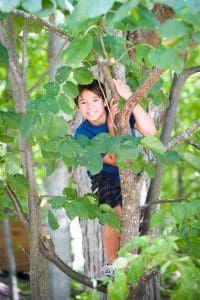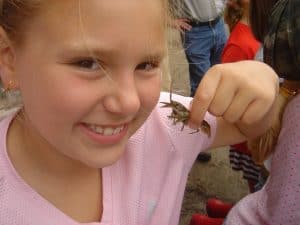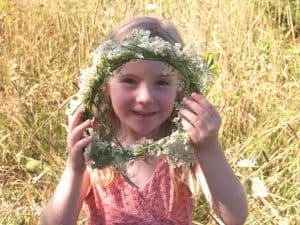A love of nature begins in childhood; every boy and girl is a budding naturalist. This should come as no surprise. Up until the agricultural revolution and, later, the emigration into villages and cities, humans grew up and lived in intimate contact with natural environments. Survival depended on detailed knowledge of plants and animals. Although our way of life has changed drastically, these ancestral instincts and affections still live within us.
Eric Fromm, a German psychologist, coined the term “biophilic” to describe the innate need that all children have to connect with other species. There is a critical window, however, that must be respected. If children are provided with rich and repeated experiences in nature from early childhood to about 14 years of age, they are far more likely to develop a life-long love appreciation for the natural world. If children spend nearly all their time indoors, however, nature may simply become a backdrop to their lives – a green blur as trivial as billboards, strip malls and parking lots.
As Harvard biologist E.O. Wilson writes, being a naturalist is not just an activity but also a rich and honorable state of mind. It is a way of “being” in the world. An ability to recognize and classify different species is seen by many cognitive psychologists as one of the eight major categories of intelligence. We see this intelligence in the young child who can readily identify different farm animals, dinosaurs or even Pokémon characters and car models. How then can adults – be they parents, grandparents, teachers or youth leaders – cultivate a naturalist’s intelligence in every child?
Set an example
- If you show enthusiasm for nature, your excitement will be noticed and copied by children. If they see you making an effort to be out in nature, they’ll want to do the same. Open doors but don’t “push them through.” Ultimately, loving nature should never be forced.
- As adults, we often forget the power of words and body language. They transmit values. If a little girl runs up to show you the caterpillar she’s just caught and you frown and say “Put that dirty thing down”, the joy and value of the discovery are ruined. To cultivate a sense of wonder, you need to use the language of wonder. “Wow – is that ever cool. Look at all the different colours and the little hairs on its back. Where did you find it? Let’s put it in a jar and keep it for a while.”
- Good questions inspire curiosity, which is the engine of learning. They also invite other questions. Encourage children to ask why, to marvel and to explore further. Let’s imagine you’re watching birds at a feeder. All of a sudden, a nuthatch flies in and begins feeding in their characteristic upside-down position. You might ask, “Why do you think it feeds upside down?” (Scientists think nuthatches can spot food from this vantage point that “right side up” birds like woodpeckers miss.) “Look how long and narrow its bill is. I wonder why?” (to get at food hidden deep in the cracks of bark). Encourage the child to ask why questions, too, and to hypothesize at what the answer might be. If you don’t know the answer either, admit it. Think of this as an opportunity to do some research together. And, if you can’t find the response, perhaps this is something that science cannot yet explain or has never investigated. Remind children that there are many things science does not yet know, and we need more bright young people like them to pursue a career in areas like biology.
- Go forth with explorer’s eyes. Be amazed at what you see, but let the child “own” the discovery. For example, you might know where to find salamanders along a certain trail. Instead of saying, “Hey! Do you want to find a salamander?” you might simply ask, “I wonder what we’ll find under these logs?” In the first question, you owned the discovery; in the second, the joy of discovery belongs to the child. It’s so satisfying for a parent or teacher to hear a child bellow out, “Look what I found!”
Play
- Play, too, is a powerful teacher, and the natural landscape lends itself to creative play. A stick becomes a magic wand or a sword; a copse of trees becomes a castle. It is through unstructured play that children cultivate their imagination. Being creative, means creating, so let children catch animals, make forts, throw rocks, climb trees, get scraped and dirty, and even disturb nature a bit, on their own and without too much coaching. These experiences are at the very heart of developing a love for the natural world. Children need to “mess around” a lot and do so as much as possible on their own. If it helps, think of the child as a little hunter-gatherer!
- Not all parents feel comfortable letting their kids roam freely. However, you can take your children outside yourself and be a “hummingbird parent”. Just stay out of the kids’ way as much as possible, so they can explore and play in nature on their own. You can always “zoom in” like a hummingbird if safety becomes an issue. Slowly increase the distance and the kids’ autonomy as time goes by. Kids thrive on autonomy, so don’t be afraid to let them loose sometimes – with a minimum of rules.
- Allow adolescents to undertake adventures with others such as overnight hiking and canoe trips.
- Children have a yearning to create dens, nests and hiding places. One of my most memorable experiences of childhood was going into the woods and building small shelters or “forts” as we called them. Children can do so using found supplies from the outdoors or the garage – old branches, sticks, fallen tree boughs with leaves, conifer branches with needles, scraps of lumber, a sheet of plastic, etc. The building process is wonderful for problem solving and creativity.
- A simple shelter can be built by propping a long pole against a tree and using branches to create a frame on both sides. Pile evergreen boughs and then leaves to cover the frame. For added comfort, pile leaves inside the hut, too.
Other ideas
- Buy your child a good hand lens (10X), a small compound microscope and, when they are 10 or so, a good pair of binoculars. Children delight in the very small, from the cells of leaves enlarged by a microscope to the feathery antennae of a moth revealed by a hand lens. Magnified, close-up views provide an entirely different perspective on nature. Teach them how to use binoculars to view birds, butterflies, dragonflies and the night sky.
- Set up a terrarium in your home or classroom. A terrarium is basically an aquarium that is filled with plants, soil and rocks suitable for terrestrial creatures. Allow your children to bring home “pets” for a few days – caterpillars, frogs, salamanders, insects, etc. Alternatively, buy an ant farm. Ants are fascinating to watch.
- Put up several different kinds of bird feeders and keep track of the different species that visit. Give your child the responsibility of keeping the feeder stocked with seed. Make sure it’s located near a window where the family spends a lot of time. Avant-Garden Shop at 165 Sherbrooke Street in Peterborough has a great selection of feeders, bird seed and other bird-related resources
- Create a collection table on which the children can display their discoveries, – feathers, flowers, seeds, cones, galls, skulls, dead insects, nests, etc. Add new items as the seasons change.
- Encourage your child to take part in junior field naturalist activities, such as those provided by the Peterborough Field Naturalists. Go to peterboroughnature.org/junior for more information.
- Take your child to the zoo. Pick a particular animal for focused observation instead of just wandering passively through the exhibits. Visit natural history museums, too, such as the Royal Ontario Museum in Toronto and the Canadian Museum of Nature in Ottawa.
- Go camping. Being outside for 24 hours a day allows you to see and hear things you will otherwise miss. Positive camping memories will make it much more likely your child will want to camp as an adult.
From the freedom to explore nature and the knowledge acquired largely by personal initiative come self-confidence, lifelong enjoyment of the outdoors, and a desire to protect our natural heritage. What more could we ask for our children and for the good of humanity?
You will find many more ideas for connecting kids to nature in “The Big Book of Nature Activities”, which I wrote with Jacob Rodenburg, executive director of Camp Kawartha.


